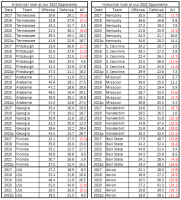You are using an out of date browser. It may not display this or other websites correctly.
You should upgrade or use an alternative browser.
You should upgrade or use an alternative browser.
Recruiting Forum Football Talk IV
- Thread starter GoBigOrange86
- Start date
- Status
- Not open for further replies.
BigSteve09
Moran
- Joined
- Mar 5, 2007
- Messages
- 19,658
- Likes
- 111,034
WarMachine
Volunteering in Indiana
- Joined
- Jan 16, 2014
- Messages
- 5,607
- Likes
- 16,297
SoilVol
No step on snek
- Joined
- Aug 8, 2019
- Messages
- 7,302
- Likes
- 51,449
That SP+ makes WAY more sense for all the reasons I listed earlier about the FPI being faulty. I certainly don't think we are deserving of being #9, but if you take the homerism out of the equation it makes sense for Miss State to be above all the schools I mentioned earlier: coaching and roster stability. Returning starting QB. Etc.A significant chunk of our prior performance variable in their model is the Pruitt years, i.e., no offense. It's just math. They had us starting around 53 last year and we were in their top 25 until after the Purdue game. We ended the year with them at #26.
So all of the teams that are overrated/underrated is because primarily they're looking at how they were over the last 4 years. 3 years ago LSU was national champs. Time has moved on but ESPN's model to a degree by design is stuck in the past. jmo.
SP+ seems to rely less on prior performance sort of like past performance is no guarantee of future success. Connelly goes in depth with every team looking at all the little details. ESPN FPI is different. They don't do a lot of common sense work with FPI. Basically, they're lazy. jmo.
edit to add: Maybe a simpler way to understand this is FPI says our offense last year (for Tennessee) was an outlier. Connelly looks at our offense last year and then looks at Heupel's offenses at UCF and says, no, it's real. jmo.
View attachment 447449
OldVolMan
Just Average Old Timer
- Joined
- Aug 26, 2019
- Messages
- 2,035
- Likes
- 3,922
MoCo_Vol
Well-Known Member
- Joined
- Dec 7, 2017
- Messages
- 18,839
- Likes
- 68,347
A significant chunk of our prior performance variable in their model is the Pruitt years, i.e., no offense. It's just math. They had us starting around 53 last year and we were in their top 25 until after the Purdue game. We ended the year with them at #26.
So all of the teams that are overrated/underrated is because primarily they're looking at how they were over the last 4 years. 3 years ago LSU was national champs. Time has moved on but ESPN's model to a degree by design is stuck in the past. jmo.
SP+ seems to rely less on prior performance sort of like past performance is no guarantee of future success. Connelly goes in depth with every team looking at all the little details. ESPN FPI is different. They don't do a lot of common sense work with FPI. Basically, they're lazy. jmo.
edit to add: Maybe a simpler way to understand this is FPI says our offense last year (for Tennessee) was an outlier. Connelly looks at our offense last year and then looks at Heupel's offenses at UCF and says, no, it's real. jmo.
View attachment 447449
So SP+ would have Georgia, Alabama, A&M, UT, Miss St, Florida, Kentucky, Ole Miss, and Auburn in their top 25
Enki_Amenra
Wanna Bet?
- Joined
- Dec 22, 2012
- Messages
- 31,181
- Likes
- 158,982
Orangeburst
Attention all Planets of the Solar Federation
- Joined
- Jun 19, 2008
- Messages
- 41,363
- Likes
- 87,981
Devo182
"Well Known Member" TWSS
- Joined
- Jan 25, 2015
- Messages
- 36,133
- Likes
- 123,044
UTProf
Well-Known Member
- Joined
- Dec 24, 2010
- Messages
- 12,321
- Likes
- 28,530
View attachment 447406Cat missilery can be deadly…
The perfect predator right there. And oh so adorable.
Devo182
"Well Known Member" TWSS
- Joined
- Jan 25, 2015
- Messages
- 36,133
- Likes
- 123,044
Devo182
"Well Known Member" TWSS
- Joined
- Jan 25, 2015
- Messages
- 36,133
- Likes
- 123,044
Yes but FPI is "quick and dirty" analytics. Not a human poll.LSU in any poll? Didn't their roster get gutted?
Jmo but it was better suited to the pre-portal explosion. They have to change the FPI formula at this point, just like recruiting services have had to start including transfers or be left in the dust of irrelevance.
engineerVOL
Super Bowl Champs, again!
- Joined
- Sep 24, 2013
- Messages
- 33,040
- Likes
- 156,540
ChattaTNVol
Well-Known Member
- Joined
- Sep 13, 2011
- Messages
- 4,911
- Likes
- 27,769
These models use a collection of variables to try to predict mostly offensive scoring and defensive scoring. Some also include special teams.
For example, SP+ says that we will have the 3rd best offense in the nation and average 41.6 points per game. It says we will have the 42nd best defense and give up 22.9 points per game on average. Subtract defense from offense, 41.6 - 22.9 = 18.7. That 18.7 is our SP+ rating. It is a handicapping tool. If we're playing a team that has a rating of 10.0 then on a neutral field we would be favored by 8.7 points.. The models rank us by our rating not by how many games we're expected to win.
Everyone has their own models so they have different approaches of trying to figure out how many points our offense will score and how many points/game our defense will give up. FPI gives a team 3.3 "extra" points for a returning QB. They also factor in stability at the head coach position. They factor in how many days of rest (bye week) and how far a team has to travel. They claim all their variables lead to a more accurate handicapping tool. Models include returning production and recruiting/talent among other things. Most models also now include transfer players added to a roster (usually at a discounted value). Again, all they're trying to do is predict the outcome of individual games.
Most models, and especially ESPN's FPI, see tremendous movement with a lot of teams after week 1 of a new season. Teams can move as much as 20 +/- spots up or down depending on how week 1 plays out across the college football landscape and strength of schedules are updated with real time results. The largest movements happen in week 1 and movement in the ranking is increasingly less as the season progresses.
I think they are probably close to the same number for our defense as Connelly. I think where SP+ differs from FPI in our case is projecting our scoring offense. So for example say we scored an average of 40 points per game last year and the 3 prior years on offense we scored an average of 20 points. Most recent year accounts for more than the 3 prior years but the 3 prior years still count. So 40*0.67 + 20*0.33 = 33.4 points per game on average. I think that's essentially the difference this year for us with FPI vs SP+. jmo.
FPI has our rating at 9.7. Last year we finished at 9.3. In 2020 we finished at 3.0. In 2019 we finished at 7.8 and in 2018 we finished at 1.2. Right now FPI believes our offensive scoring last year was an outlier based on recent history. They think we'll be marginally better this year than last year but not by much. I disagree but whatever. They gon' learn. jmo.
For example, SP+ says that we will have the 3rd best offense in the nation and average 41.6 points per game. It says we will have the 42nd best defense and give up 22.9 points per game on average. Subtract defense from offense, 41.6 - 22.9 = 18.7. That 18.7 is our SP+ rating. It is a handicapping tool. If we're playing a team that has a rating of 10.0 then on a neutral field we would be favored by 8.7 points.. The models rank us by our rating not by how many games we're expected to win.
Everyone has their own models so they have different approaches of trying to figure out how many points our offense will score and how many points/game our defense will give up. FPI gives a team 3.3 "extra" points for a returning QB. They also factor in stability at the head coach position. They factor in how many days of rest (bye week) and how far a team has to travel. They claim all their variables lead to a more accurate handicapping tool. Models include returning production and recruiting/talent among other things. Most models also now include transfer players added to a roster (usually at a discounted value). Again, all they're trying to do is predict the outcome of individual games.
Most models, and especially ESPN's FPI, see tremendous movement with a lot of teams after week 1 of a new season. Teams can move as much as 20 +/- spots up or down depending on how week 1 plays out across the college football landscape and strength of schedules are updated with real time results. The largest movements happen in week 1 and movement in the ranking is increasingly less as the season progresses.
I think they are probably close to the same number for our defense as Connelly. I think where SP+ differs from FPI in our case is projecting our scoring offense. So for example say we scored an average of 40 points per game last year and the 3 prior years on offense we scored an average of 20 points. Most recent year accounts for more than the 3 prior years but the 3 prior years still count. So 40*0.67 + 20*0.33 = 33.4 points per game on average. I think that's essentially the difference this year for us with FPI vs SP+. jmo.
FPI has our rating at 9.7. Last year we finished at 9.3. In 2020 we finished at 3.0. In 2019 we finished at 7.8 and in 2018 we finished at 1.2. Right now FPI believes our offensive scoring last year was an outlier based on recent history. They think we'll be marginally better this year than last year but not by much. I disagree but whatever. They gon' learn. jmo.
WarMachine
Volunteering in Indiana
- Joined
- Jan 16, 2014
- Messages
- 5,607
- Likes
- 16,297
Vols410
Well-Known Member
- Joined
- Dec 1, 2012
- Messages
- 2,842
- Likes
- 11,227
All good and helpful info.These models use a collection of variables to try to predict mostly offensive scoring and defensive scoring. Some also include special teams.
For example, SP+ says that we will have the 3rd best offense in the nation and average 41.6 points per game. It says we will have the 42nd best defense and give up 22.9 points per game on average. Subtract defense from offense, 41.6 - 22.9 = 18.7. That 18.7 is our SP+ rating. It is a handicapping tool. If we're playing a team that has a rating of 10.0 then on a neutral field we would be favored by 8.7 points.. The models rank us by our rating not by how many games we're expected to win.
Everyone has their own models so they have different approaches of trying to figure out how many points our offense will score and how many points/game our defense will give up. FPI gives a team 3.3 "extra" points for a returning QB. They also factor in stability at the head coach position. They factor in how many days of rest (bye week) and how far a team has to travel. They claim all their variables lead to a more accurate handicapping tool. Models include returning production and recruiting/talent among other things. Most models also now include transfer players added to a roster (usually at a discounted value). Again, all they're trying to do is predict the outcome of individual games.
Most models, and especially ESPN's FPI, see tremendous movement with a lot of teams after week 1 of a new season. Teams can move as much as 20 +/- spots up or down depending on how week 1 plays out across the college football landscape and strength of schedules are updated with real time results. The largest movements happen in week 1 and movement in the ranking is increasingly less as the season progresses.
I think they are probably close to the same number for our defense as Connelly. I think where SP+ differs from FPI in our case is projecting our scoring offense. So for example say we scored an average of 40 points per game last year and the 3 prior years on offense we scored an average of 20 points. Most recent year accounts for more than the 3 prior years but the 3 prior years still count. So 40*0.67 + 20*0.33 = 33.4 points per game on average. I think that's essentially the difference this year for us with FPI vs SP+. jmo.
FPI has our rating at 9.7. Last year we finished at 9.3. In 2020 we finished at 3.0. In 2019 we finished at 7.8 and in 2018 we finished at 1.2. Right now FPI believes our offensive scoring last year was an outlier based on recent history. They think we'll be marginally better this year than last year but not by much. I disagree but whatever. They gon' learn. jmo.
One clarifying point I’d make is that the 41.6/22.9 off/def PPG isn’t a projected PPG (which depends on our SOS), but a predicted points scored against an average opponent.
WarMachine
Volunteering in Indiana
- Joined
- Jan 16, 2014
- Messages
- 5,607
- Likes
- 16,297
FPI is garbage ... until they rank the Vols #1. Then, maybe, it will be respectable.These models use a collection of variables to try to predict mostly offensive scoring and defensive scoring. Some also include special teams.
For example, SP+ says that we will have the 3rd best offense in the nation and average 41.6 points per game. It says we will have the 42nd best defense and give up 22.9 points per game on average. Subtract defense from offense, 41.6 - 22.9 = 18.7. That 18.7 is our SP+ rating. It is a handicapping tool. If we're playing a team that has a rating of 10.0 then on a neutral field we would be favored by 8.7 points.. The models rank us by our rating not by how many games we're expected to win.
Everyone has their own models so they have different approaches of trying to figure out how many points our offense will score and how many points/game our defense will give up. FPI gives a team 3.3 "extra" points for a returning QB. They also factor in stability at the head coach position. They factor in how many days of rest (bye week) and how far a team has to travel. They claim all their variables lead to a more accurate handicapping tool. Models include returning production and recruiting/talent among other things. Most models also now include transfer players added to a roster (usually at a discounted value). Again, all they're trying to do is predict the outcome of individual games.
Most models, and especially ESPN's FPI, see tremendous movement with a lot of teams after week 1 of a new season. Teams can move as much as 20 +/- spots up or down depending on how week 1 plays out across the college football landscape and strength of schedules are updated with real time results. The largest movements happen in week 1 and movement in the ranking is increasingly less as the season progresses.
I think they are probably close to the same number for our defense as Connelly. I think where SP+ differs from FPI in our case is projecting our scoring offense. So for example say we scored an average of 40 points per game last year and the 3 prior years on offense we scored an average of 20 points. Most recent year accounts for more than the 3 prior years but the 3 prior years still count. So 40*0.67 + 20*0.33 = 33.4 points per game on average. I think that's essentially the difference this year for us with FPI vs SP+. jmo.
FPI has our rating at 9.7. Last year we finished at 9.3. In 2020 we finished at 3.0. In 2019 we finished at 7.8 and in 2018 we finished at 1.2. Right now FPI believes our offensive scoring last year was an outlier based on recent history. They think we'll be marginally better this year than last year but not by much. I disagree but whatever. They gon' learn. jmo.
BarrythesnoUT
Nico Era
- Joined
- Dec 31, 2011
- Messages
- 3,266
- Likes
- 4,393
Pridedad
AKA Row Dad
- Joined
- Dec 20, 2019
- Messages
- 2,868
- Likes
- 13,632
butchna
Sit down and tell me all about it...way over there
- Joined
- Jan 6, 2013
- Messages
- 103,088
- Likes
- 206,804
ChattaTNVol
Well-Known Member
- Joined
- Sep 13, 2011
- Messages
- 4,911
- Likes
- 27,769
A few days ago I made up these tables to show how teams scoring margins on the year change from year to year. Teams rise and fall all the time based on a number or real world things, like not having an offensive line or not having a QB or not having a defense, etc.
In the table for the 2022 projection I used Connelly's numbers for offense and defense and so the margins projected for 2022 are the same as the SP+ rating. The historical offensive and defensive numbers are from CFBstats.
Again, my point was really I think Georgia in particular is going to have a drop off this year, similar to Alabama last year, and so I think Georgia is overrated, even by SP+. jmo.

In the table for the 2022 projection I used Connelly's numbers for offense and defense and so the margins projected for 2022 are the same as the SP+ rating. The historical offensive and defensive numbers are from CFBstats.
Again, my point was really I think Georgia in particular is going to have a drop off this year, similar to Alabama last year, and so I think Georgia is overrated, even by SP+. jmo.

drvenner
Home Sweet Home
- Joined
- Jan 17, 2010
- Messages
- 40,730
- Likes
- 158,215
Chuckie
"They won't nobody up here pay for it, buddy"
- Joined
- Jul 28, 2009
- Messages
- 4,041
- Likes
- 10,952
jakez4ut
Patience... It's what's for dinner
- Joined
- Jul 7, 2005
- Messages
- 70,754
- Likes
- 124,283
Enki_Amenra
Wanna Bet?
- Joined
- Dec 22, 2012
- Messages
- 31,181
- Likes
- 158,982
- Status
- Not open for further replies.





